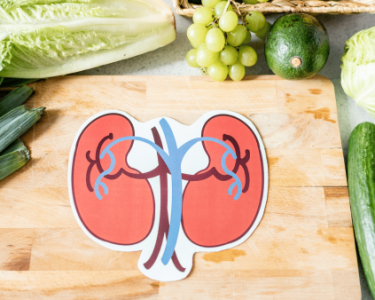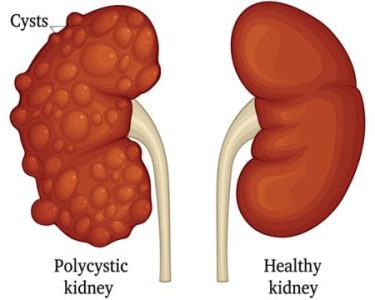What is polycystic kidney disease?
- Polycystic kidney disease (PKD) causes cysts to form on the kidneys.
- There are three types of PKD: autosomal dominant PKD, autosomal recessive PKD, and acquired cystic kidney disease.
- There is no cure for PKD, but there are treatments that can control symptoms.
Polycystic kidney disease (PKD) is an inherited kidney disorder. It causes fluid-filled cysts to form in the kidneys. PKD may impair kidney function and eventually cause kidney failure.
PKD is the fourth leading cause of kidney failure. People with PKD may also develop cysts in the liver and other complications.
What are the symptoms of polycystic kidney disease?
There is all symptoms of polycystic kidney disease. You can read:
Many people live with PKD for years without experiencing symptoms associated with the disease. Cysts typically grow 0.5 inches or larger before a person starts noticing symptoms. Initial symptoms for polycystic kidney disease associated with PKD can include:
- pain or tenderness in the abdomen
- blood in the urine
- frequent urination
- pain in the sides
- urinary tract infection (UTI)
- kidney stones
- pain or heaviness in the back
- skin that bruises easily
- pale skin color
- fatigue
- joint pain
- nail abnormalities
Children with autosomal recessive PKD may have symptoms that include:
- high blood pressure
- UTI
- frequent urination
Symptoms in children may resemble other disorders. It is important to get medical attention for a child experiencing any of symptoms listed above.
What causes of polycystic kidney disease?
Causes for polycystic kidney disease (PKD) is generally inherited. Less commonly, it develops in people who have other serious kidney problems. There are three types PKD causes of polycystic kidney disease.
Autosomal dominant PKD
Autosomal dominant (ADPKD) is sometimes called adult PKD, and accounts for about 90 percent of cases. Someone who has a parent with PKD has a 50 percent chance of developing this condition.
Symptoms usually develop later in life, between the ages of 30 and 40. However, some people begin to experience symptoms in childhood.
Autosomal recessive PKD
Autosomal recessive PKD (ARPKD) is much less common than ADPKD. It is also inherited, but both parents must carry the gene for the disease.
People who are carriers of ARPKD will not have symptoms if they have only one gene. If they inherit two genes, one from each parent, they will have ARPKD.
There are four types of ARPKD:
- perinatal form is present at birth
- neonatal form occurs within the first month of life
- infantile form occurs when the child is 3 to 12 months old
- juvenile form occurs after the child is 1 year old
Acquired cystic kidney disease
Acquired cystic kidney disease (ACKD) is not inherited and it usually occurs later in life.
It usually develops in people who already have other kidney problems. And it is more common in those who have kidney failure or are on dialysis.
How is polycystic kidney disease diagnosed?
Because ADPKD and ARPKD are inherited, your doctor will review your family history. They may initially order a complete blood count to look for anemia or signs of infection and a urinalysis to look for blood, bacteria, or protein in your urine.
To diagnose all three types of PKD, your doctor may use imaging tests to look for cysts of the kidney, liver, and other organs. Imaging tests used to diagnose PKD include:
- abdominal ultrasound: a non-invasive test that uses sound waves to look at your kidneys for cysts
- abdominal CT scan: can detect smaller cysts in the kidneys
- abdominal MRI scan: uses strong magnets to image your body to visualize kidney structure and look for cysts
- intravenous pyelogram: uses a dye to make your blood vessels show up more clearly on an X-ray
What are the complications of polycystic kidney disease?
In addition to the symptoms generally experienced with PKD, as cysts on the kidneys grow larger there may be complications.
Some of these complications can include:
- weakened areas in the walls of arteries, known as aortic or brain aneurysms
- cysts on and in the liver
- cysts in the pancreas and testicles
- pouches or pockets in the wall of the colon, or diverticula
- cataracts or blindness
- liver disease mitral valve prolapse
- anemia, or insufficient red blood cells
- bleeding or bursting of cysts
- high blood pressure
- liver failure
- kidney stones
- cardiovascular disease
What is the treatment of polycystic kidney disease?
The goal of polycystic kidney disease treatment is to manage symptoms and avoid complications. Controlling high blood pressure is the most important part of treatment for polycystic kidney disease.
Some treatment of polycystic kidney disease options may include:
- pain medication, except Ibuprofen, which is not recommended as it may worsen kidney disease
- blood pressure medication
- antibiotics to treat UTIs
- a low sodium diet
- diuretics to help remove excess fluid from the body
- surgery to drain cysts and help relieve discomfort
With advanced PKD that polycystic kidney disease causes renal failure, dialysis and kidney transplant may be necessary. One or both of the kidneys may need to be removed.
Coping and support for polycystic kidney disease
A diagnosis of PKD may mean changes and considerations for you and your family. You may experience a range of emotions when you receive a PKD diagnosis and as you adjust to living with the condition. Reaching out to a support network of family and friends can be helpful.
You may also wish to reach out to a dietitian, who can recommend dietary steps to help you keep blood pressure low and reduce the work required of the kidneys, which must filter and balance electrolytes and sodium levels.
There are several organizations that provide support and information for those living with PKD:
- The PKD Foundation has chapters all across the country to support those with PKD and their families. Visit their website to find a chapter near you.
- The National Kidney Foundation (NKF) offers education and support groups to kidney patients and their families.
- American Association of Kidney Patients (AAKP) engages in advocacy to protect the rights of kidney patients in all levels of government and insurance organizations.
You can also talk to your nephrologist or local dialysis clinic to find support groups in your area. You don’t have to be on dialysis in order to access these resources.
If you aren’t ready or don’t have the time to attend a support group, each of these organizations have online resources and forums available.
Reproductive support
Because polycystic kidney disease can be an inherited condition, your doctor may recommend seeing a genetic counselor. They can help you figure out a map of your family’s medical history with respect to PKD.
Genetic counseling may be an option that can help you weigh important decisions, such as the likelihood your child could have PKD.
Kidney failure and transplant options
One of the most serious complications of polycystic kidney disease is kidney failure. This is when the kidneys are no longer able to filter waste products, maintain fluid balance, and maintain blood pressure on their own. When this occurs, your doctor will discuss options with you that may include a kidney transplant or dialysis treatments to act as artificial kidneys.
If your doctor does place you on a kidney transplant list, there are several factors that determine your placement. These include your overall health, expected survival, and time you have been on dialysis. It’s also possible that a friend or relative could donate a kidney to you. Because people can live with only one kidney with relatively few complications, this can be an option for families who have a willing donor.
The decision to undergo a kidney transplant or donate a kidney to a person with kidney disease can be a difficult one. Speaking to your nephrologist can help you weigh your options. You can also ask what medications and treatments can help you live as well as possible in the meantime. According to the University of Iowa, the average kidney transplant will allow kidney function from 10 to 12 years.
What is the outlook for people with polycystic kidney disease?
For most people, PKD slowly gets worse over time. It is estimated that 50 percent of people with PKD will experience kidney failure by age 60. This number increases to 60 percent by age 70. Because the kidneys are such important organs, their failure may start to affect other organs, such as the liver.
Proper medical care can help you manage PKD symptoms for years. If you don’t have other medical problems, you may be a good candidate for a kidney transplant.
Also, you may consider speaking with a genetic counselor if you have a family history of PKD and are planning to have children.
Source Link :https://www.healthline.com/health/polycystic-kidney-disease#Overview1




